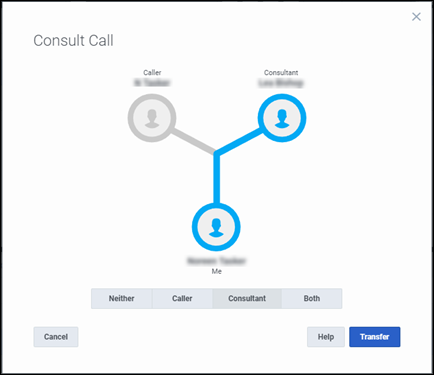- Contents
- Index
Consult Transfer a Scripter Call
Requirements: Access Control Rights determine which Attendant Profiles, User Queues, Workgroup Queues and Station Queues are available as transfer targets. By default, the Transfer dialog box searches the Company Directory, and the appropriate Attendant Profiles, User Queues, Workgroup Queues, and Station Queues for matching names and numbers.
Transferring a call after speaking to the intended recipient is called a consult transfer.
-
Inform the caller that he or she is going to be transferred.
-
In the Interaction Scripter view, click the Transfer button.
-
In the Transfer dialog box, in the Transfer To: text box, type all of part of the recipient’s name or number.
Tip: If the drop-down list does not contain the recipient you expected, check the search criteria selected in the Options drop-down list and adjust them if necessary.
-
From the drop-down list, do one of the following:
-
-
Select "Dial [your entry] as Digits" to convert a text entry into numbers.
-
Select the appropriate name and associated extension number.
-
Result: Status information appears for a selected CIC user. It shows whether the transfer recipient is logged onto a CIC client and is able to accept the transferred call. This can help you decide what kind of call transfer to use.
-
If you are transferring the call to an agent who is not participating in the campaign, check Disposition this contact record after transfer.
Result: The form remains in the Interaction Scripter view until you select a disposition.
-
Click the down arrow on the Transfer button and select Consult.
Result: The Consult Call dialog box appears. The original caller is placed on hold. A call is placed to the intended transfer recipient.
Note: The highlighted line indicates the parties who are connected and can speak to each other.

-
Do one of the following:
-
-
If the intended recipient (Consultant) answers his or her phone, and agrees to the transfer, click Transfer.
-
Result: The call is transferred to the Consultant and is removed from your queue. If you did not select Disposition this contact record after transfer, the Interaction Scripter view clears.
-
-
To speak to the caller again without exiting the transfer operation, click Caller.
-
Note: This puts the call to the Consultant on hold. You might use this feature if the recipient is unavailable to take the interaction and you want to see if the caller would like to be transferred to someone else.
-
-
To speak to the Consultant again without exiting the transfer operation, click Consultant.
-
To enable a three-way conversation with the Caller, Consultant and you, click Both.
-
Note: This creates a conference call. You can now speak to both the Caller and the Consultant. If you later complete the transfer, the conference call is replaced by a standard two-party call.
-
-
To put both parties on hold, click Neither.
-
Tip: This enables you to talk to someone else or make another call without involving the caller or consultant.
-
-
If the transfer recipient does not answer the phone or does not agree to the transfer, click Cancel.
-
Result: The Consult Call dialog box closes and the Transfer dialog box reappears. The call is taken off hold, and you are reconnected to it.
Tip: If for some reason you can't perform a consult transfer, you can use the Transfer dialog box to choose another way to handle this call. Or you can transfer a call to another person’s voicemail, park a call on another person’s extension, or transfer a call without consulting the recipient.
-
If you selected Disposition this contact record after transfer, select a Disposition button in the Interaction Scripter view.



